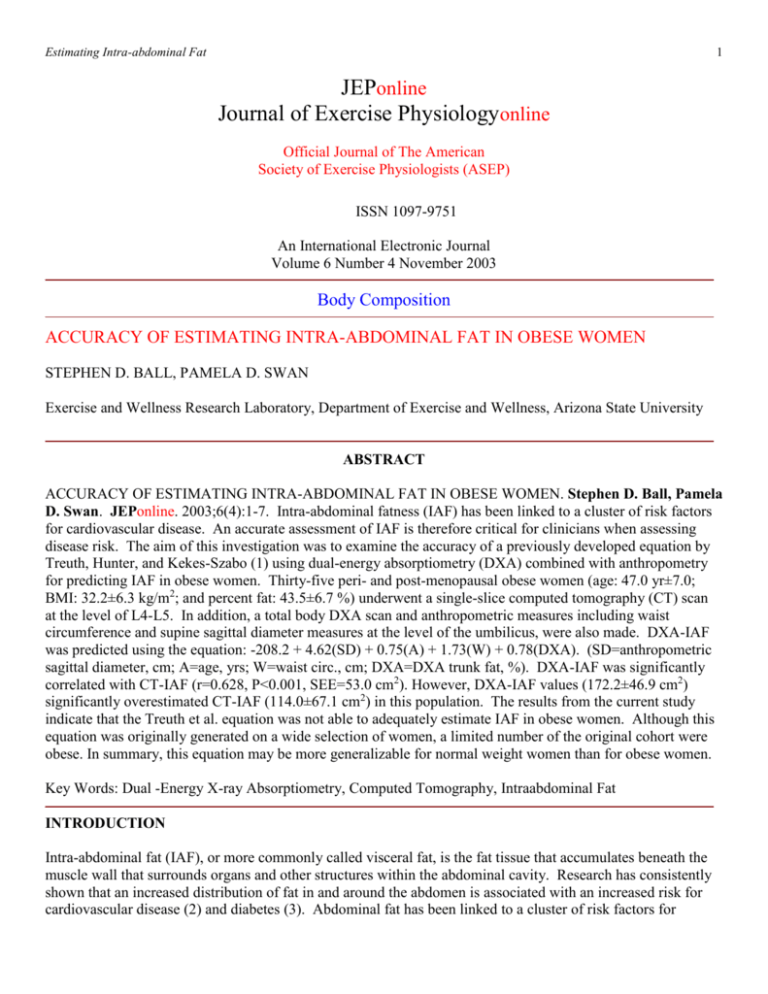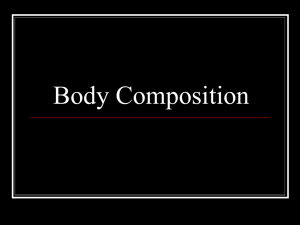accuracy of estimating intra-abdominal fat in obese women
advertisement

Estimating Intra-abdominal Fat
1
JEPonline
Journal of Exercise Physiologyonline
Official Journal of The American
Society of Exercise Physiologists (ASEP)
ISSN 1097-9751
An International Electronic Journal
Volume 6 Number 4 November 2003
Body Composition
ACCURACY OF ESTIMATING INTRA-ABDOMINAL FAT IN OBESE WOMEN
STEPHEN D. BALL, PAMELA D. SWAN
Exercise and Wellness Research Laboratory, Department of Exercise and Wellness, Arizona State University
ABSTRACT
ACCURACY OF ESTIMATING INTRA-ABDOMINAL FAT IN OBESE WOMEN. Stephen D. Ball, Pamela
D. Swan. JEPonline. 2003;6(4):1-7. Intra-abdominal fatness (IAF) has been linked to a cluster of risk factors
for cardiovascular disease. An accurate assessment of IAF is therefore critical for clinicians when assessing
disease risk. The aim of this investigation was to examine the accuracy of a previously developed equation by
Treuth, Hunter, and Kekes-Szabo (1) using dual-energy absorptiometry (DXA) combined with anthropometry
for predicting IAF in obese women. Thirty-five peri- and post-menopausal obese women (age: 47.0 yr±7.0;
BMI: 32.2±6.3 kg/m2; and percent fat: 43.5±6.7 %) underwent a single-slice computed tomography (CT) scan
at the level of L4-L5. In addition, a total body DXA scan and anthropometric measures including waist
circumference and supine sagittal diameter measures at the level of the umbilicus, were also made. DXA-IAF
was predicted using the equation: -208.2 + 4.62(SD) + 0.75(A) + 1.73(W) + 0.78(DXA). (SD=anthropometric
sagittal diameter, cm; A=age, yrs; W=waist circ., cm; DXA=DXA trunk fat, %). DXA-IAF was significantly
correlated with CT-IAF (r=0.628, P<0.001, SEE=53.0 cm2). However, DXA-IAF values (172.2±46.9 cm2)
significantly overestimated CT-IAF (114.0±67.1 cm2) in this population. The results from the current study
indicate that the Treuth et al. equation was not able to adequately estimate IAF in obese women. Although this
equation was originally generated on a wide selection of women, a limited number of the original cohort were
obese. In summary, this equation may be more generalizable for normal weight women than for obese women.
Key Words: Dual -Energy X-ray Absorptiometry, Computed Tomography, Intraabdominal Fat
INTRODUCTION
Intra-abdominal fat (IAF), or more commonly called visceral fat, is the fat tissue that accumulates beneath the
muscle wall that surrounds organs and other structures within the abdominal cavity. Research has consistently
shown that an increased distribution of fat in and around the abdomen is associated with an increased risk for
cardiovascular disease (2) and diabetes (3). Abdominal fat has been linked to a cluster of risk factors for
Estimating Intra-abdominal Fat
2
cardiovascular disease called “Syndrome X” (4) or the Metabolic Syndrome (5) , which includes
hyperlipidemia, insulin resistance, hypertension, and hyperinsulinemia (5, 6). However, it appears that
increased IAF, a component of total abdominal fat, may be even more predictive of these complications than
abdominal fat itself (7).
Computed tomography (CT) is an imaging technique capable of directly measuring abdominal tissue and IAF
with a very high degree of accuracy (8). However, this procedure is expensive and requires skilled technicians.
CT scans also expose subjects to ionizing radiation. In clinical practice abdominal adiposity has been estimated
using indirect anthropometric methods such as the waist to hip ratio (WHR) or waist circumference. These are
inexpensive and quick procedures that give estimates of fat distribution. Although some researchers feel that
anthropometric estimates are an acceptable measure of intraabdominal fat (9) and therefore disease risk, others
have suggested that this technique is only moderately related to the amount of abdominal visceral adipose tissue
(10-13). For example, the percent of variance explained (R2) in IAF by the WHR has been reported to be <0.58
(14). These estimates are also subject to variability between technicians and do not accurately assess changes in
visceral fat mass (15). Researchers have thus begun to evaluate other techniques that are easy, accessible and
more accurate estimates of IAF.
A safer (less radiation compared to CT) and less expensive method to assess IAF may be with dual-energy x-ray
absorptiometry (DXA). DXA has typically been used to assess bone mineral density but has also been found to
be a valuable tool in assessing body composition (16) and regional body composition (1, 17, 18). In 1993,
Svendsen et al. (18) developed two regression equations that used DXA data along with several anthropometric
measurements in order to predict IAF (R2=0.63 and 0.71, respectively) in postmenopausal women. Treuth et al.
(1), in an attempt to validate the Svendsen et al. equations, developed a new generalizable equation for
estimating IAF from DXA in women of varying ages and body composition. The resulting equation was more
highly correlated with IAF (R2 = 0.81) than the Svendsen equation. Utilizing CT as the criterion method, this
new model used % trunk fat from DXA in conjunction with anthropometric data (sagittal diameter, waist
circumference), and age in order to predict the amount of IAF fat {y=-208.2 + 4.62 (sagittal diameter, cm) +
0.75 (age, y) + 1.73 (waist, cm) + 0.78 (trunk fat %)}. Although Treuth et al. (1) reported that some obese
women were used in developing their equation (% fat 12.9-51.6), the mean body mass index BMI (kg/m2) for
the 151 women in the estimation sample was relatively low (23.84.7) compared to the average range of BMI
(26.7-28.5) reported for middle-aged women (19). It is not clear if this equation would be generalizable to
women with relatively greater body fat amounts. The purpose of this study was to examine the accuracy of the
Treuth, Hunter, and Kekes-Szabo (1) equation to predict IAAT in obese women.
METHODS
Subjects
Thirty–five obese women (total % fat >30% from DXA) with a mean age of 47.47.0 years (range 35-65) living
in a large metropolitan area in the southwestern United States volunteered to participate in the study. All
subjects were informed of the procedures and risks of the study and signed a written informed consent in
accordance with the policies and procedures of the University Human Subjects Institutional Review Board.
Anthropometry
Body weight was measured to the nearest 0.1 kg and height to the nearest 0.5 cm. Duplicate circumferences
were taken to the nearest 0.1 cm with a Gulick tension retractable tape. Waist circumference was measured as
the narrowest part of the torso between the ribs and the iliac crest. Abdominal circumference was measured as
the extension of the abdomen at the level of the umbilicus (20). In several subjects (N=7) it was impossible to
identify the waist circumference, therefore the abdominal circumference was used as an alternative. Sagittal
diameter was measured as the maximum diameter of the abdomen in the sagittal plane. All sagittal diameter
measurements were taken in the supine position with the knees bent using sliding calipers at the point directly
above the umbilicus (21). The average of the duplicate measures was used in the statistical analysis.
Estimating Intra-abdominal Fat
3
Computed tomography
Abdominal adipose tissue was assessed by computed tomography (CT) (Picker PQ 6000, Picker International,
Cleveland, Ohio) at the level of the fourth to fifth lumbar vertebra (L4-L5). The scan was performed at 125 kV
with an 8 mm slice thickness. An initial scan was taken from a lateral view to establish the bony landmarks on
a radiograph of the skeleton as a reference to establish the position of the scan to the nearest mm. Each woman
was examined in a supine position with her arms stretched above her head. Visceral and total fat were
calculated with a fat tissue-highlighting technique using an attenuation range of -190 to -30 Hounsfield units
(HU). Each area was delineated with a computerized pen and then expressed as cross sectional area of tissue
(cm2). Visceral adipose tissue was distinguished by drawing a line within the inner portion of the muscle wall
surrounding the abdominal cavity. Total fat area was determined by demarcating the whole abdominal scan
with the electronic pen. Then visceral area was subtracted from the total fat area to calculate abdominal
subcutaneous tissue. A single investigator performed all CT measures. Test-retest reliability for repeated CT
scan analyses of 10 subjects yielded a correlation coefficient of 0.99.
Dual Energy X-ray Absorptiometry
Dual energy x-ray absorptiometry (DXA) (model DPX-IQ 5705; Lunar Radiation Corporation, Madison, WI)
was used to assess percent body fat and regional tissue composition analysis. The 20 minute scan (pencil beam)
was used on all women. The Lunar DPX-IQ computer using software version 4.6b calculated total trunk % fat.
Total trunk % fat was designated as all the trunk area (not arms, legs or head) below the neck and to the
diagonal leg cuts.
Statistical Analyses
Statistical analyses were performed using commercial computer software (SPSS v. 9 for Windows).
Descriptive statistics were calculated for subject characteristics. Mean differences in IAAT between the CT
measured values and the predicted values were determined with a paired t- test. Linear regression and Pearson
Product-Moment correlations defined the relationship between the prediction equation (y=-208.2 + 4.62
(sagittal diameter, cm) + 0.75 (age, y) + 1.73 (waist, cm) + 0.78 (trunk fat %) and CT measured IAAT. An
alpha level of 0.05 was used to indicate statistical significance.
RESULTS
The descriptive characteristics of body composition for this study compared to those reported from Treuth et al.
(1) are shown in Table 1. Subjects ranged from 30.1-60.4 % fat.
There was a significant difference (P<0.001) in measured (114.067.1) versus predicted (172.246.9) IAAT
values. The correlation coefficients of IAAT by CT with anthropometry and DXA are shown in Table 2.
IAAT was significantly correlated with weight, body mass index, sagittal diameter, waist circumference, and
umbilicus circumference. The Bland and Altman (22) plot of residual scores illustrates the overestimation of
IAAT by the prediction equation for each subject (Figure 1).
DISCUSSION
Other research has demonstrated that the combination of DXA with simple anthropometric measures can be
used to estimate the amount of IAAT in women (1, 23). However, only a limited number of studies have
examined the accuracy of this technique in obese women. Although more work is necessary, it appears that the
equations of Treuth et al. (1) do not sufficiently estimate IAAT in obese women (R2=0.39). The possible areas
of discrepancy arise from inconsistencies in anthropometric measurements and also the assumptions and
limitations in DXA technology.
Estimating Intra-abdominal Fat
4
Table 1. Body composition comparison data.
Current Study
(N = 35)
Range
MeanSD
Age (yrs)
35 - 67
477.07
Weight (kg)
(57.1 - 133.2)
85.616.9
Height (m)
(1.5 - 1.8)
1.630.07
BMI (kg/m2)
(21.1 - 46.3)
32.26.31
Sagittal diameter (cm)
(21.2 - 38.1)
30.54.4
Waist circ. (cm)
(76.4 - 139.8)
99.416.3
Umbilicus circ. (cm)
(94.6 - 142)
116.9411.17
1
Total body fat (%)
(30.1 - 60.2)
43.56.7
1
Total trunk fat (%)
(29.6 - 55.5)
41.25.1
IAAT (cm2)
(35.8
- 399.3)
114.067.1
2
SAAT (cm )
(205.9 - 775.9)
429.9147.3
Treuth et al., 1995
(N = 151)
Range
MeanSD
44
17-77
(43.2 - 119.0)
63.513.3
(1.39 - 1.83)
1.630.06
(16.8 – 43.7)
23.84.7
(14.5 - 40.5)
20.94.2
(57.5 - 112.0)
73.410.6
(10.9 – 139.0)
79.914.4
(12.9 - 51.6)
32.39.0
(8.3 - 53.0)
29.910.3
(10.7
- 335.4)
72.355.0
207.2122.0 (35.5 - 612.1)
MeanSD. Range in parentheses. IAAT=Intra-abdominal adipose tissue measured by CT;
SAAT=subcutaneous abdominal adipose tissue measured by CT; 1=measured by DXA.
Predicted vs Measured IAAT
IAAT (cm 2 )
One potential source of error is from the
measurement of the anthropometric values
used in the equation. For example, in some
large women with primarily upper body fat
distribution, the “narrow” location of the
waist circumference was difficult to
distinguish on the torso. In these instances
(n=7), we recorded the umbilicus
circumference that is easy to identify and a
reliable measurement, but is located inferior to
the waist and is typically a larger value. This
inconsistency in measurement may limit the
validity of the waist measurement in obese
women. It is worth noting that substitution of
the waist circumference by the umbilicus
circumference for all subjects reduced the R2
from 0.39 to 0.32.
250
150
50
-50
-150
-250
25
35
45
55
65
% Body Fat
Figure 1. Values are the difference between predicted (Treuth et al.
equation) IAAT and measured (CT) IAAT for each subject.
Positive values represent an overestimation by the prediction
equation.
Another anthropometric source of inaccuracy may be the inconsistency in the measurement of the sagittal
diameter. There are no standard procedures in measuring sagittal diameter and it was not clear in the original
equation if this measurement was taken with the knees bent or straight. In this study we measured the sagittal
diameter in the supine position with the knees bent. Any difference in body position may have influenced the
measurement value as somewhat smaller sagittal diameter values will be obtained with the legs straight.
It is noteworthy that the correlation between IAAT with DXA trunk % fat was not statistically significant.
Although some studies have found substantially higher correlations (0.6-0.8) between IAAT and DXA trunk %
fat (1), others have not reported significant correlations (10). Ferland et al. (10) found that total adipose tissue
from CT at the abdominal level was not significantly correlated with total body fat mass in obese women. It
seems reasonable to assume that if there is not a consistent relationship between DXA measured values of trunk
Estimating Intra-abdominal Fat
5
% fat with IAAT, then the DXA technique may be less sensitive to subtle changes in IAAT and thus will result
in invalid estimates of IAAT in obese women. Interestingly, when an analysis was run with two non-obese (%
fat <30) women included in the sample, the Pearson correlation between IAAT and predicted IAAT improved
slightly from 0.628 to 0.665. It is possible that an increased correlation might be expected simply because the
range in IAAT was extended. But perhaps this increased correlation might imply that the Treuth et al. equation
may be more appropriate for normal weight than obese women. The Trueth equation should be validated on a
less obese group to determine the answer.
Interestingly, a recent study by Bertin et al. (23) using a different DXA model (QDR 2000/W HOLOGIC) also
attempted to apply the Treuth et al. equation to their sample (44 overweight women) and found results similar to
ours. They found that the mean difference between the estimated and measured IAAT was significantly larger
(+318.8 cm2, p< 0.01) with a correlation of 0.57. Thus, consistent with our findings, Bertin et al. (23) also
found the Treuth et al. equation to overestimate the amount of IAAT in obese women.
However, Bertin et al. (23) did find promising results for the usefulness of DXA in estimating visceral fat in
obese subjects when the abdominal trunk region was analyzed with more sophisticated software at a higher
precision. Using a protocol version of the DXA software, Bertin et al. (23) identified two abdominal transverse
diameters on the DXA scans. Their new prediction equation [79.6 (sagittal diameter – subcutaneous fat width)
X (transverse internal diameter/height) – 149] yielded an R2 of 0.86 (p < 0.0001). Perhaps DXA software that
divides the abdominal region into more precise sections is necessary in order to use DXA to measure visceral
fat in obese women.
Even though DXA is gaining momentum as the gold standard for assessing body composition, it still has
limitations in accurately assessing trunk fat in obese women. For example, DXA fat analysis technology has
limitations in assessing and delimiting differences between breast tissue and arm fat tissue due to the overlap of
fat in the scan area. Although increases in breast tissue may increase the overall regional measurement, this
trunk fat tissue is not associated with IAAT. In addition, the effect of how DXA software extrapolates pixels
over bone in the trunk area may influence the estimation of trunk fat in obese subjects. Since pixels directly
over bone are extrapolated from non-skeleton pixels, a proportionally greater error would occur in obese
subjects because a greater tissue mass is being estimated and not measured. These factors raise questions about
DXA’s ability to predict the amount of IAAT in obese subjects.
Others have attempted to develop prediction equations with sample sizes similar to ours (18). However, most
experts agree that a minimum of 100-400 subjects are necessary to develop and validate accurate prediction
equations (24). Therefore with our small sample (n=35), it was not statistically possible or practical to develop
an accurate regression equation specific to this group. Nevertheless, in an attempt to establish the relative
importance of each of the variables tested by Treuth et al., stepwise linear regression was conducted using our
data. The variables entered into our model were the same as those used by Treuth et al. Similar to the Treuth et
al. equation, sagittal diameter was the first variable to enter into the equation. However, contrary to the Treuth
equation, the R square change for the remaining variables (DXA trunk fat, age, waist circumference) were not
significant, and therefore, none of these variables significantly added to our equation. Thus, DXA trunk fat %
was not a significant predictor of IAAT for our sample. In regards to the Treuth et al. equation, it is surprising
that the R square change (0.80 to 0.81) for the addition of DXA trunk fat % was significant.
The results from the current study indicate that the Treuth et al. equation was not able to adequately estimate
IAAT in obese women. Unfortunately, it was not statistically feasible to develop a new regression equation for
obese women. However, the results from this study support the call for researchers to develop new prediction
equations and/or different DXA software/hardware to estimate IAAT in high-risk populations such as obese
Estimating Intra-abdominal Fat
6
women. Although DXA technology is a safe and fairly inexpensive estimate of body composition, its
limitations in accurately assessing regional adiposity may restrict its use for estimating IAAT.
ACKNOWLEDGEMENTS
Grateful acknowledgement is given to Eliot Brinton, M.D., Kristin Araki, M.S., DXA technician Cheryl
Berneir, RT(R)(M), CT technician Bruce Mable, ARRT/CT, and the Carl T Hayden VA Medical Center for
their contributions. Additional financial support of this research was provided by a grant from the National
Heart Association.
Address for Correspondence: Stephen Daniel Ball, University of Missouri, 315A Gwynn Hall, Columbia MO
65211; Phone: (573) 882-2334; FAX: (573) 884-5449; Email: ballsd@missouri.edu
REFERENCES
1. 1. Treuth MS., Hunter GR, Kekes-Szabo K. Estimating intraabdominal adipose tissue in women by dualenergy X-ray absorptiometry. Am J Clin Nutr. 1995; 62:527-532.
2. Donahue RP, Abbott RD. Central obesity and coronary heart disease in men. Lancet. 1987; 2:1215.
3. Despres JP, Nadeau A, Tremblay A, Ferland M, Moorjani S, Lupien PJ, Theriault G, Pinault S, Bouchard C.
Role of deep abdominal fat in the association between regional adipose tissue distribution and glucose tolerance
in obese women. Diabetes. 1989; 38:304-309.
4. Reaven G. M. Role of insulin resistance in human disease (syndrome X): an expanded definition. Annu Rev
Med. 1993; 44:121-131.
5. Despres JP, Lesage M, Lemieux S, Prud'Homme D. Grouping of risk factors for cardiovascular diseases in
visceral obesity. Therapeutic implications. Ann Endocrinol (Paris). 1995; 56:101-105.
6. Kissebah AH., Vydelingum N, Murray R, Evans DJ, Hartz AJ, Kalkhoff RK, Adams PW. Relation of body
fat distribution to metabolic complications of obesity. J Clin Endocrinol Metab. 1982; 54:254-260.
7. Despres JP, Moorjani S, Ferland M, Tremblay A, Lupien PJ, Nadeau A, Pinault S, Theriault G, Bouchard C.
Adipose tissue distribution and plasma lipoprotein levels in obese women. Importance of intra-abdominal fat.
Arteriosclerosis. 1989; 9:203-210.
8. Seidell J. C., Bakker CJ, van der Kooy K. Imaging techniques for measuring adipose-tissue distribution--a
comparison between computed tomography and 1.5-T magnetic resonance. Am J Clin Nutr. 1990; 51:953-957.
9. Jakicic JM., Donnelly JE, Jawad AF, Jacobsen DJ, Gunderson SC, Pascale R. Association between blood
lipids and different measures of body fat distribution: effects of BMI and age. Int J Obes Relat Metab Disord.
1993; 17:131-137.
10. Ferland M., Despres JP, Tremblay A, Pinault S, Nadeau A, Moorjani S, Lupien PJ, Theriault G, Bouchard
C. Assessment of adipose tissue distribution by computed axial tomography in obese women: association with
body density and anthropometric measurements. Br J Nutr. 1989; 61:139-148.
11. Ross R., Leger L, Morris D, de Guise J, Guardo R. Quantification of adipose tissue by MRI: relationship
with anthropometric variables. J Appl Physiol. 1992; 72:787-795.
12. Seidell JC, Oosterlee A, Thijssen MA, Burema J, Deurenberg P, Hautvast JG, Ruijs JH. Assessment of
intra-abdominal and subcutaneous abdominal fat: relation between anthropometry and computed tomography.
Am J Clin Nutr. 1987; 45:7-13.
13. Sjostrom L. Kvist H. Regional body fat measurements with CT-scan and evaluation of anthropometric
predictions. Acta Med Scand Suppl. 1988; 723:169-177.
14. Despres JP, Prud'homme D, Pouliot MC, Tremblay A, Bouchard C. Estimation of deep abdominal adiposetissue accumulation from simple anthropometric measurements in men. Am J Clin Nutr. 1991; 54:471-477.
15. van der Kooy K., Leenen R, Seidell JC, Deurenberg P, Droop A, Bakker CJ. Waist-hip ratio is a poor
predictor of changes in visceral fat. Am J Clin Nutr. 1993; 57:327-333.
Estimating Intra-abdominal Fat
7
16. Kohrt WM. Body composition by DXA: tried and true? Med Sci Sports Exerc. 1995; 27:1349-1353.
17. Jensen MD, Kanaley JA, Reed JE, Sheedy PF. Measurement of abdominal and visceral fat with computed
tomography and dual-energy x-ray absorptiometry. Am J Clin Nutr. 1995; 61:274-278.
18. Svendsen OL, Hassager C, Bergmann I, Christiansen C. Measurement of abdominal and intra-abdominal fat
in postmenopausal women by dual energy X-ray absorptiometry and anthropometry: comparison with
computerized tomography. Int J Obes Relat Metab Disord. 1993; 17:45-51.
19. Kuczmarski RJ, Flegal KM, Campbell SM, Johnson CL. Increasing prevalence of overweight among US
adults. The National Health and Nutrition Examination Surveys, 1960 to 1991. Jama. 1994; 272:205-211.
20. Lohman T, Roche AF, Martorell R. Anthropometric Standardization Manual. Champaign, IL: Human
Kinetics, 1988
21. Zamboni M, Turcato E, Armellini F, Kahn HS, Zivelonghi A, Santana H, Bergamo-Andreis IA, Bosello O.
Sagittal abdominal diameter as a practical predictor of visceral fat. Int J Obes Relat Metab Disord. 1998;
22:655-660.
22. Bland JM, Altman DG. Statistical methods for assessing agreement between two methods of clinical
measurement. Lancet. 1986; 1:307-310.
23. Bertin E, Marcus C, Ruiz JC, Eschard JP, Leutenegger M. Measurement of visceral adipose tissue by DXA
combined with anthropometry in obese humans. Int J Obes Relat Metab Disord. 2000; 24:263-270.
24. Lohman TG. Skinfolds and body density and their relation to body fatness: a review. Hum Biol. 1981;
53:181-225.







